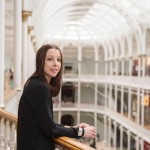Back in March, I was extremely lucky to be awarded a Jonathan Ruffer Curatorial Research Grant from Art Fund, to allow me to attend this year’s SCHMUCK, and the satellite programme of international events, exhibitions, talks and workshops within Munich Jewellery Week.
This festival for contemporary jewellery is considered one of the most important platforms, and sounding boards within the field, with hundreds of makers, students, educators, curators, gallerists and collectors, traveling from all over the world to visit the city to be inspired by the diverse programme that is on offer.
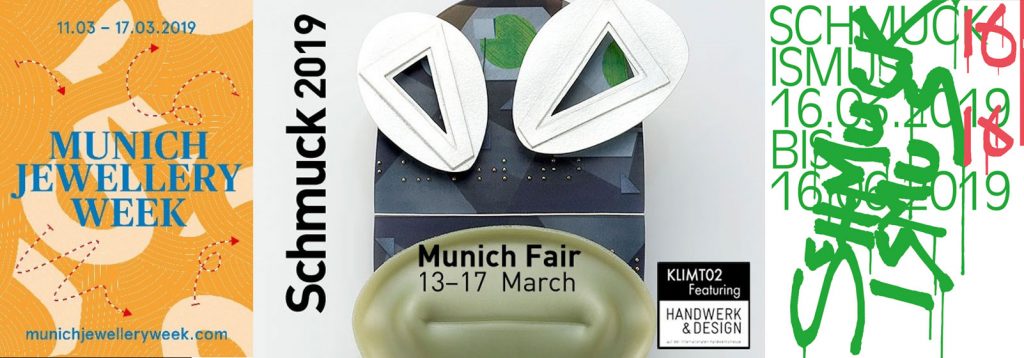
Initiated back in 1959, and considered to be the annual event for goldsmiths and jewellery designers worldwide, this year saw SCHMUCK celebrating 60 years of showcasing the best examples in the field of contemporary art jewellery from across the globe. With 65 jewellers from 22 countries represented within SCHMUCK alone, let alone the outlining gallery stands, or the design and craft exhibitions that make up the Internationale Handwerksmesse Trade Fair, meant that I spent one of my first day’s in Munich immersed within the most current practice that was happening on an international platform within craft and design.
On display was a plethora of works that reflected the highly diverse approaches to jewellery, from traditional metalworking to conceptual pieces and material experimentation; some engaged in themes of politics and environmental activism; to those works that challenged the perception of jewellery as merely an item of adornment and privilege.

Alongside SCHMUCK, there were several special exhibitions including Frame, which represented leading contemporary jewellery galleries from across the globe; Meister der Moderne, organized by the Handwerkskammer München und Oberbayern, showcasing the diversity of international arts and crafts; and Talente, which has been part of Internationale Handwerksmesse for more than 30 years, exhibiting young up-and-coming designers in art, craft and design.
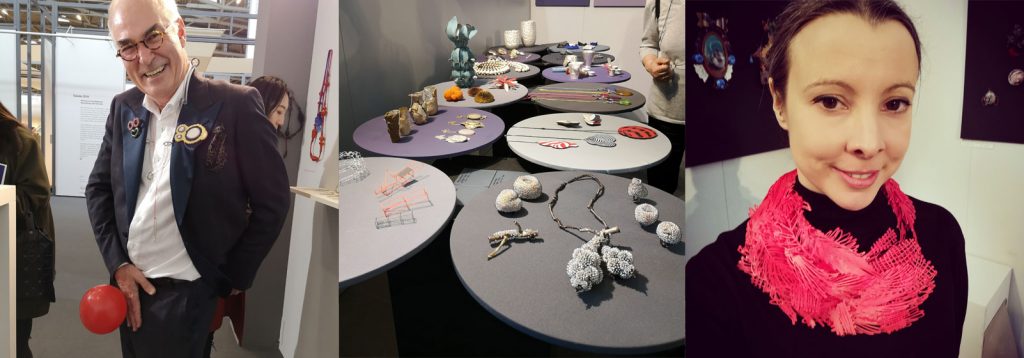
of the many stands in Frame; trying on the Swedish artist Sofia Bjorkman What has the bird done? neckpiece at her gallery Platina’s stand. I first met Sofia in 2017 when I visited Stockholm as part of the Art Fund New Collecting Award project.
The day was an amazing opportunity to meet with gallerists from across the globe who highlighted works by some of their leading jewellery artists, allowing me to better understand and identify the global trends and design movements that are happening, whilst discovering new works and artists of which I had not been aware of before. I made new acquaintances like the fabulous New Zealand jewellery collector Garth O’Brien, who I started chatting to whilst I was visiting his home countries The National gallery’s stand, only to discover he’d just acquired a piece by the Glasgow School of Art Artist in Residence Ailsa Morrant, who he had met the day before, whilst also re-establishing contact with others whom I have met in the past.
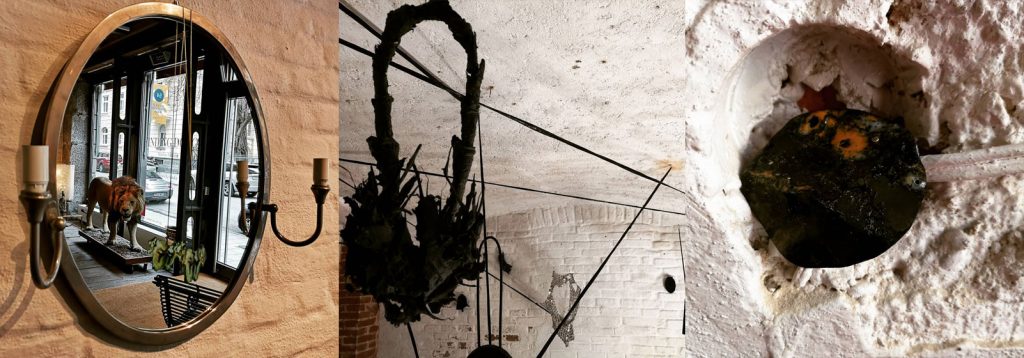
Away from Internationale Handwerksmesse, and within Munich, over 100 satellite exhibitions and events had taken over the city centre. Munich Jewellery Week (MJW) is an independent initiative, which runs in parallel to the Internationale Handwerksmesse Trade Fair and SCHMUCK. Over the past decade, this has expanded to encompass over 100 participants, showcasing avant-garde contemporary jewellery by both established and up-and-coming designers from all over the world.
From student shows to established names, Art Jewellery was to be found in a host of venues across the city, from museums to underground stations; design shops to hotels; and so many other amazing places where you could find lions wearing bug brooches; to a basement full of black jewellery; pop up boutiques where holes in the walls are filled with pieces, to snail races.
With so much going on it could be easy to lose your way, but thanks to Current Obsession, who are a jewellery magazine and platform based in the Netherlands that supports and promotes contemporary jewellery, the map they produce, and website makes it easier to navigate around the city.

In addition, I also had as guides the jewellery artist Silvia Weidenbach who currently lecturers at Glasgow School of Art, and Jennifer Gray, Head of the Silversmithing & Jewellery department at Edinburgh College of Art, and are both MJW alumni. They very generously let me tag along and take advantage of the additional studio tours they had arranged for their students, and provided introductions to artists and educators within the sector.
This was a lovely extra, as I was able to meet not only internationally acclaimed artists such as Yutaka Minegishi, Helen Britton and David Bielander, (who decided I looked like I would suit his Python Necklace. It was tempting to keep but I don’t think I would have got it back in my carry on) in their own studio; be part of private tours to the Staatliche Antikensammlungen’s jewellery gallery hosted by Dr Astrid Fendt, whose Etrucian Diadem I will never forget; getting close to a piece by one of my Modernist heroes Naum Slutsky during a tour by Dr Xenia Riemann-Tyroller, Curator at Die neue Sammlung -The Design Museum; visiting the internationally acclaimed jewellery and silversmithing department at the Academy of Fine Arts Munich; but also, to learn about the students’ own practice and their thoughts on the MJW. So I have to say a big thanks goes out to them both.

Chance encounters with old and new friends and colleagues on the street happened often, where you would exchange tips on where to go and who we wanted to see, whilst on other occasions conversations were struck up due to the piece of jewellery being worn, so you or they could find out more. Even when eating or having a coffee you would end up talking jewellery with the stranger at the table next to you. Munich for this week really was all about jewellery.
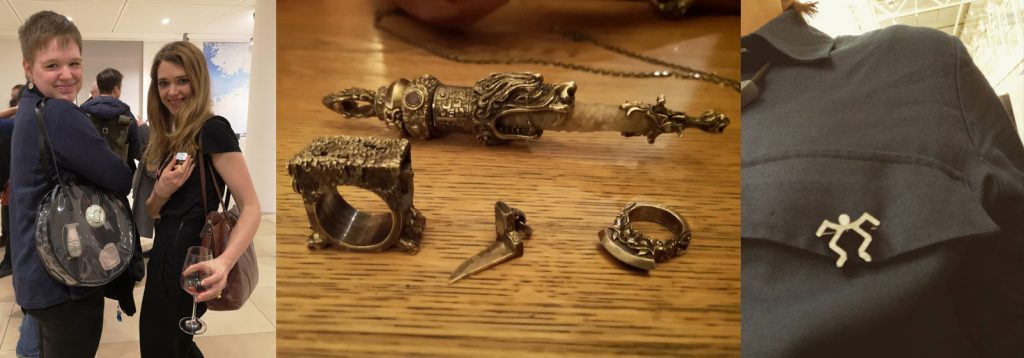
Attending such events is extremely valuable to a curator’s development, as it allows us to further develop our knowledge and understanding within the field that we are studying, and seeing at first-hand how the world of contemporary jewellery is developing internationally, and the resulting design tropes that are emerging. Whilst also providing the opportunity to engage, network and build relationships with international curators, artists, makers and specialists that we would not have likely met other than at events such as this.
My first Schmuck was inspiring, sometimes overwhelming with the amount to see and do, I definitely had tired feet by the end; but immensely valuable and hugely enjoyable. This project was made possible with a Jonathan Ruffer Curatorial Research Grant from Art Fund: I’m extremely grateful that it allowed me to be able to make this research trip, to view so many beautiful, provocative, conceptual, amazing works of art and craft; discuss the sector with other curators and collectors; develop new contacts and new networks; and to gauge where National Museums Scotland’s own jewellery collection sits within this dialogue, and where we should look to develop the collections further.
